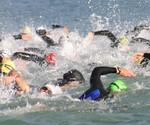
Three reasons men swim faster than women in wetsuits
It doesn't take a swim coach to see that men swim faster than women in general. It's just how men and women were built and we all know that! But in wetsuits, when we compare men and women, we often see that men get an increased advantage from wearing wetsuits than their female counterparts.
With summer racing fast approaching, it seems like a good time to dust off that wetsuit and take a look at how it changes how we swim, and what advantages / disadvantages there are to wearing it.
In observing several squad swimmers in both wetsuit and non-wetsuit swimming, both men and women improved their times wearing wetsuits, but men's times improved more significantly. I observed three main points:
The women that got the least benefit from wearing the wetsuit were:
1. Swimmers with good body positions in the water
2. Swimmers with strong kicks
3. Swimmers with weak upper-body strength
The men that got the most benefit had bad body positions, very weak kicks and strong upper-body strength.
BODY POSITION
The wetsuits main advantage is that it improves body position. The rubber in the wetsuit goes a long way to lifting your hips and body out of the water. The less of your body that is in the water, the less drag you create and the faster you swim. The better your body position, the less relative change (Please note that swimmers in good body positions still get faster and thus hold faster times than swimmers with bad body positions – the benefit just isn't as large). In comparing men against women, we often see that women have better balance in the water (hips relatively higher) than men. One reason is due to the differences in fat distribution in the body. So the advantage women gain is generally relatively less than men.
KICKING
I often hear my female squad swimmers being upset about a male squad member beating them at the latest ocean swim race, when they have been swimming faster than them at training all year.
The stronger your kick is the better your body position often can be, and the greater you use your kick for propulsion instead of your arms. Because women (in general) have better ankle flexibility than men, they also in general have stronger kicks. When we put wetsuits on, the buoyancy of the suit can sometimes lift the legs almost out of the water, reducing the effect of kicking and increasing the importance of the pull.
UPPER BODY STRENGTH
Even the most flexible wetsuit requires some energy to bend the rubber around your shoulder as your arm strokes through the water. As men generally have stronger upper body strength than females, they cope much better with this extra resistance.
IN CONCLUSION...
What does this mean for women swimmers? Leave the wetsuit at home? No. Women still had improved times in wetsuits, just not as much as men. It means that women may benefit from doing an increased amount of swimming in a wetsuit. By spending more time doing the specific wetsuit training, your arms should get used to this resistance and get stronger.
In New Zealand, at every race we do this summer we will be wearing a wetsuit! The best thing to do is to get that wetsuit on and get training to get used to it. Not just in the open water, but in a swimming pool. Open water training is great for practising open water swimming, but not great for getting feedback. Get into a pool away from waves and currents and really feel how your wetsuit affects your stroke. In Auckland the Parnell Baths is a great outdoor pool to do some wetsuit swims in, either by yourself, or in one of our morning or evening squads. You can swim your programme, get feedback, and really get to know your wetsuit.
Spencer Vickers is the Head Coach of Parnell Baths Swim Squad and Assistant Head Coach at the Tepid Baths. He provides one-on-one coaching at the Tepid Baths. Email spencer@futuredreams.co.nz or call 021 993 577.
